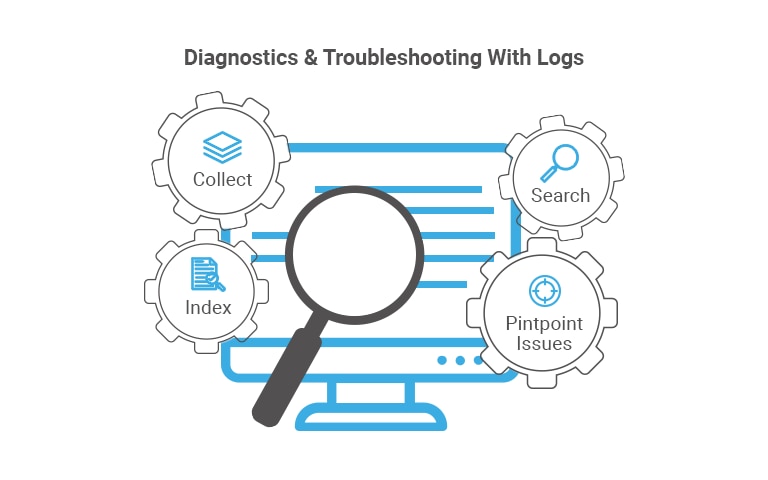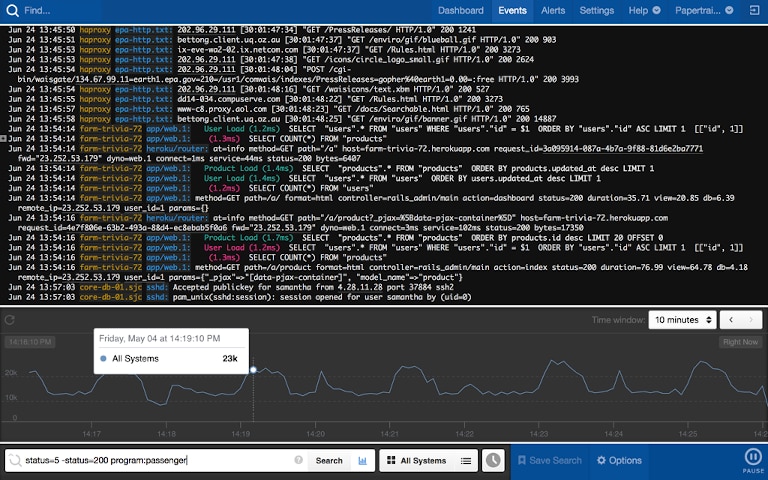In IT environments, logs originate from a wide range of sources, including networking devices (routers, firewalls, switches, load balancers, etc.), physical and virtual servers, databases, applications, and more. Traditionally, organizations in highly regulated industries maintained these logs for keeping an audit trail and meeting their compliance mandates. This led to the evolution of Security Information and Event Management (SIEM) practices. However, logs are also crucial in real-time performance monitoring of infrastructure and applications. Unlike traditional metrics-based monitoring, which could only let administrators identify symptoms of a problem, log monitoring is more beneficial as it facilitates root-cause analysis and troubleshooting. Organizations have to invest significant time and resources in log aggregation.

However, over the years, IT environments have become increasingly complex. DevOps teams in modern organizations have to monitor a mix of legacy and next-gen devices, monolithic and containerized microservices-based applications in a hybrid environment. In such environments, log volumes can expand to unmanageable proportions within minutes. Moreover, teams also have to be ready for sudden spikes in log volumes. Reliable management of all these logs requires a scalable logging setup. Traditional log analyzers and log viewers aren’t suited to meet these requirements. We will discuss how cloud-based log management tools can simplify log aggregation and help you make the most out of your logs.
Benefits of Cloud-Based Log Aggregation Tools
- Fewer Configuration Challenges
- Higher Scalability
- Seamless Integrations
- Dedicated Support
- Lower Total Cost of Ownership (TCO)
Fewer Configuration Challenges
Many large organizations often rely on open-source ELK-stack (Elasticsearch, Logstash, Kibana) for log management and analytics. While this stack can provide a high level of flexibility and scale, it needs careful planning and significant time and efforts in the configuration. If you stuck with a configuration issue, you have to rely on your team’s expertise or community support for its resolution. On the other hand, most commercial cloud-based solutions offer self-provisioning web portals, which simplify initial setup, upgrades, and access and account management related tasks. With Logging as a Service (LaaS), organizations can start monitoring their environment within minutes.
Higher Scalability
While on-premises log management setups aren’t rare, most organizations these days choose cloud for the purpose. However, the DIY-approach to creating a cloud-based logging setup with open-source solutions can also pose challenges. In large-scale production environments, organizations need to add numerous components for data resiliency (e.g., message brokers such as RabbitMQ, Kafka, etc.) and security (Nginx). The number of Elasticsearch nodes for indexing and storage has to be increased as log volumes increase. This is where commercial tools like SolarWinds® Papertrail™, SolarWinds Loggly®, Logz.io, etc. can make your job easier. With these tools, you don’t have to face infrastructure-related challenges and can easily scale up to manage a large volume of logs.
Seamless Integrations
Cloud-based tools are designed to meet varying needs of organizations, which means they’re easy to integrate with different tools across organizations’ existing setups. DevOps teams can integrate their cloud-based tools with their CI/CD pipelines or make them an extension of their network and security operations centers. Further, cloud-based log aggregators are lightweight and can ingest and transform logs from a wide range of sources quickly. Many of these tools support agentless log collection, which means you don’t have to install any software to collect logs.
Dedicated Support
Most vendors offering cloud logging services also provide dedicated technical support to solve a myriad of technical challenges. With their support, one can expect issues related to any rare and complex configuration, upgrades, and maintenance to be resolved quickly as per the service levels.
Lower Total Cost of Ownership (TCO)
The costs involved in the provisioning and maintenance of a dedicated on-premises logging setup can get out of hand when the log volumes increase. On the other hand, cloud-based logging services offer higher retention rates and easier management of log data, at a much lower TCO. LaaS-based tools with their flexible pricing can be highly beneficial for small teams that want to access real-time log analysis features but have budget constraints.
How to Select a Cloud-Based Solution for Log Aggregation
There are numerous types of log management tools focused on of log monitoring and analysis. For instance, there are advanced analytics-based solutions, which claim to use machine learning algorithms to correlate infrastructure and application logs for SIEM purposes. Further, there are application performance monitoring (APM) solutions, which track various metrics and traces along with logs for full visibility into distributed systems. If you’re looking for a simple log aggregation tool, you may find it difficult to shortlist a tool among all such options. However, we have evaluated most of these tools and recommend SolarWinds Papertrail as one of the most capable cloud-based log management solutions. SolarWinds offers a free trial of Papertrail, which will help you get accustomed to its features and capabilities.

Papertrail is a simple and highly intuitive tool and typically takes only a few minutes to set up. Select features for seamless log ingestion, parsing, search, live tail, and alerting make this tool highly effective for monitoring live environments. As logs are parsed, one can monitor them in near real-time using the live tail features in the event viewer, which presents log messages in an infinite scroll. It’s easy to scroll up and down this viewer or skip to a specific time to inspect any critical event. The tool supports common search operators and provides quick results, even when searching through a large volume of logs. It also saves important searches, so you don’t have to type complex queries during the troubleshooting. Further, Papertrail provides easy integration with tools like Slack, Pagerduty, and more for alerts and notifications. These and many other features make Papertrail a popular tool for log aggregation and analysis.
Conclusion
Log aggregation is the first step towards observability into complex systems. As application architectures evolve, organizations need to analyze log streams in real-time. Cloud-based log management tools like Papertrail can help with a seamless collection of logs for troubleshooting and diagnostics. Moreover, as part of the SolarWinds APM suite, Papertrail provides easy integration with tools like Pingdom® and AppOptics® for full-stack monitoring. Start a free trial of Papertrail now.
